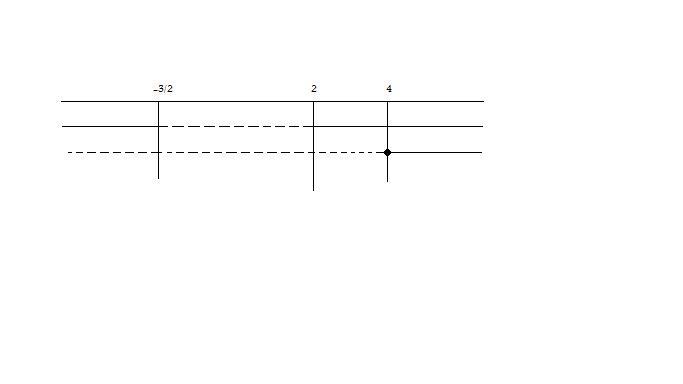[math]\begin{cases} (x/2+1)^2-5/4>5/8x \\ 4x-7>=3(x-1) \ \end{cases}[/math]
[math]\begin{cases} (x^2)/4+1+x-5/4>5/8x \\ 4x-7>=3(x-1) \ \end{cases}[/math]
;[math]\begin{cases} (x/2+1)^2-5/4>5/8x \\ 4x-7>=3x-3 \ \end{cases}[/math]
;[math]\begin{cases} (2x^2+4+4x-10)/8>5/8x \\ x>=4 \ \end{cases}[/math]
;Moltiplicando ambo i membri della prima disequazione per
[math]8[/math]
, si ha:[math]\begin{cases} 2x^2+4+4x-10>5x \\ x>=4 \ \end{cases}[/math]
;Semplificando
[math]\begin{cases} 2x^2-x-6>0 \\ x>=4 \ \end{cases}[/math]
;Studiamo la disequazione di secondo grado
[math]2x^2-x-6>0[/math]
[math]Delta=b^2-4ac=(-1)^2-(4 \cdot 2 \cdot (-6))=1+48=49[/math]
[math]x_(1,2)=(-b+-\sqrt{Delta})/(2a)=(1+-\sqrt(49))/4=(1+-7)/4 => x_1=2 ^^ x_2=-3/2[/math]
. Siccome il segno del coefficiente di
[math]x^2[/math]
è concorde col segno della disequazione,prenderemo gli intervalli esterni, quindi soluzione della disequazione sarà:
[math]x>-3/2 vv x>2[/math]
.Pertanto
[math]\begin{cases} x>-3/2 vv x>2 \\ x>=4 \ \end{cases}[/math]
;Soluzione del sistema sarà l'intersezione delle soluzioni delle singole disequazioni che lo compongono.

Quindi la soluzione sarà:
[math]x>=4[/math]
.








 Accedi a tutti gli appunti
Accedi a tutti gli appunti
 Tutor AI: studia meglio e in meno tempo
Tutor AI: studia meglio e in meno tempo